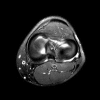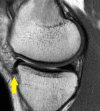Should the meniscal height be considered for preoperative sizing in meniscal transplantation?
- PMID: 28233022
- PMCID: PMC5847198
- DOI: 10.1007/s00167-017-4461-6
Should the meniscal height be considered for preoperative sizing in meniscal transplantation?
Abstract
Purpose and hypothesis: In preoperative sizing for meniscal transplantation, most authors take into consideration the length and width of the original meniscus, but not its height. This study aimed at evaluating (1) whether the meniscal height is associated with the meniscal length and width, (2) whether the heights of the meniscal segments are associated with the individual's anthropometric data, (3) whether the heights of the meniscal segments are associated with each other in the same meniscus, and (4) the degree of symmetry of the meniscal dimensions between the right and left knees.
Methods: In this cross-sectional, observational study, two independent radiologists measured the meniscal length, width and height in knee magnetic resonance imaging scans obtained from 25 patients with patello-femoral pain syndrome. Reproducibility of measurements was calculated with intraclass correlation coefficients. Associations between the anthropometric data and the meniscal measurements, the meniscal length and width versus height, and the heights of the meniscal segments in the same meniscus were examined with Pearson's correlation.
Results: Inter-observer reliability was excellent (>0.8) for length and height and good (0.6-0.8) for width measurements. There was also excellent agreement (>0.8) for the length and width of the menisci in the right and left knees. The heights of the horns of the lateral meniscus showed good agreement (0.6-0.8), while the heights of the other meniscal segments had excellent agreement between the sides (>0.8). There were significant associations with generally low (r < 0.5) correlation between the heights of the meniscal segments and the lengths and widths of the menisci, between the meniscal height and anthropometric data, and between the heights of the meniscal segments in the same meniscus. Correlations between anthropometric data and meniscal length and width were generally high (r > 0.7).
Conclusions: There was excellent agreement between the meniscal dimensions of the right and left knees, and a weak association between the meniscal height with the meniscal width and length, between the height of the menisci with anthropometric data and between the heights of the segments in the same meniscus. The height of the meniscal segments may be a new variable in preoperative meniscal measurement.
Keywords: Accuracy; Dimensional measurement; Graft; Imaging; Inter-observer variation; Joint; Knee; MRI scans; Magnetic resonance; Medial; Meniscus; Meniscus lateral; Tibial menisci; Transplantation.
Conflict of interest statement
Conflict of interest
The authors declare no conflicts of interest.
Funding information
This study was funded by
Figures





Similar articles
-
Which Are the Most Reliable Methods of Predicting the Meniscal Size for Transplantation?Am J Sports Med. 2016 Nov;44(11):2876-2883. doi: 10.1177/0363546516653203. Epub 2016 Jul 15. Am J Sports Med. 2016. PMID: 27422172
-
Radiographic Methods Are as Accurate as Magnetic Resonance Imaging for Graft Sizing Before Lateral Meniscal Transplantation.Am J Sports Med. 2020 Dec;48(14):3534-3540. doi: 10.1177/0363546520963095. Epub 2020 Oct 27. Am J Sports Med. 2020. PMID: 33108216
-
The use of contralateral knee magnetic resonance imaging to predict meniscal size during meniscal allograft transplantation.Arthroscopy. 2014 Oct;30(10):1287-93. doi: 10.1016/j.arthro.2014.05.009. Epub 2014 Jul 18. Arthroscopy. 2014. PMID: 25047011
-
Is radiographic measurement of bony landmarks reliable for lateral meniscal sizing?Am J Sports Med. 2011 Mar;39(3):582-9. doi: 10.1177/0363546510390444. Epub 2011 Jan 13. Am J Sports Med. 2011. PMID: 21233406
-
Management of Long-Term Complications in the Setting of Lateral Meniscal Deficiency After Saucerization of a Discoid Lateral Meniscus in an Adolescent Patient: A Case Report and Review of the Literature.JBJS Case Connect. 2018 Oct-Dec;8(4):e102. doi: 10.2106/JBJS.CC.18.00054. JBJS Case Connect. 2018. PMID: 30540611 Review.
Cited by
-
Which modality is most accurate in sizing meniscal allografts for transplant - A systematic review.J Orthop. 2025 Mar 15;69:130-136. doi: 10.1016/j.jor.2025.03.024. eCollection 2025 Nov. J Orthop. 2025. PMID: 40212943 Review.
-
Meniscal Injury Does Not Significantly Affect the Dimensions of the Intact Meniscus in the Opposite Compartment of the Knee.Orthop J Sports Med. 2020 Feb 27;8(2):2325967120904328. doi: 10.1177/2325967120904328. eCollection 2020 Feb. Orthop J Sports Med. 2020. PMID: 32656288 Free PMC article.
-
Variations of cross-sectional meniscal morphology between similar-sized menisci: implications on donor selection for meniscal allograft transplantation.Arch Orthop Trauma Surg. 2022 Jun;142(6):1099-1107. doi: 10.1007/s00402-021-03909-w. Epub 2021 May 5. Arch Orthop Trauma Surg. 2022. PMID: 33950275
-
Use of magnetic resonance imaging to determine laterality of meniscal size in healthy volunteers.PLoS One. 2020 Jan 23;15(1):e0228040. doi: 10.1371/journal.pone.0228040. eCollection 2020. PLoS One. 2020. PMID: 31971967 Free PMC article.
-
Morphological Analysis of Normal Meniscus on Magnetic Resonance Imaging (MRI)-Based Three-Dimensional Reconstruction Models in Healthy Chinese Adults.Med Sci Monit. 2020 Oct 15;26:e927101. doi: 10.12659/MSM.927101. Med Sci Monit. 2020. PMID: 33056944 Free PMC article. Clinical Trial.
References
Publication types
MeSH terms
LinkOut - more resources
Full Text Sources
Other Literature Sources
Medical

